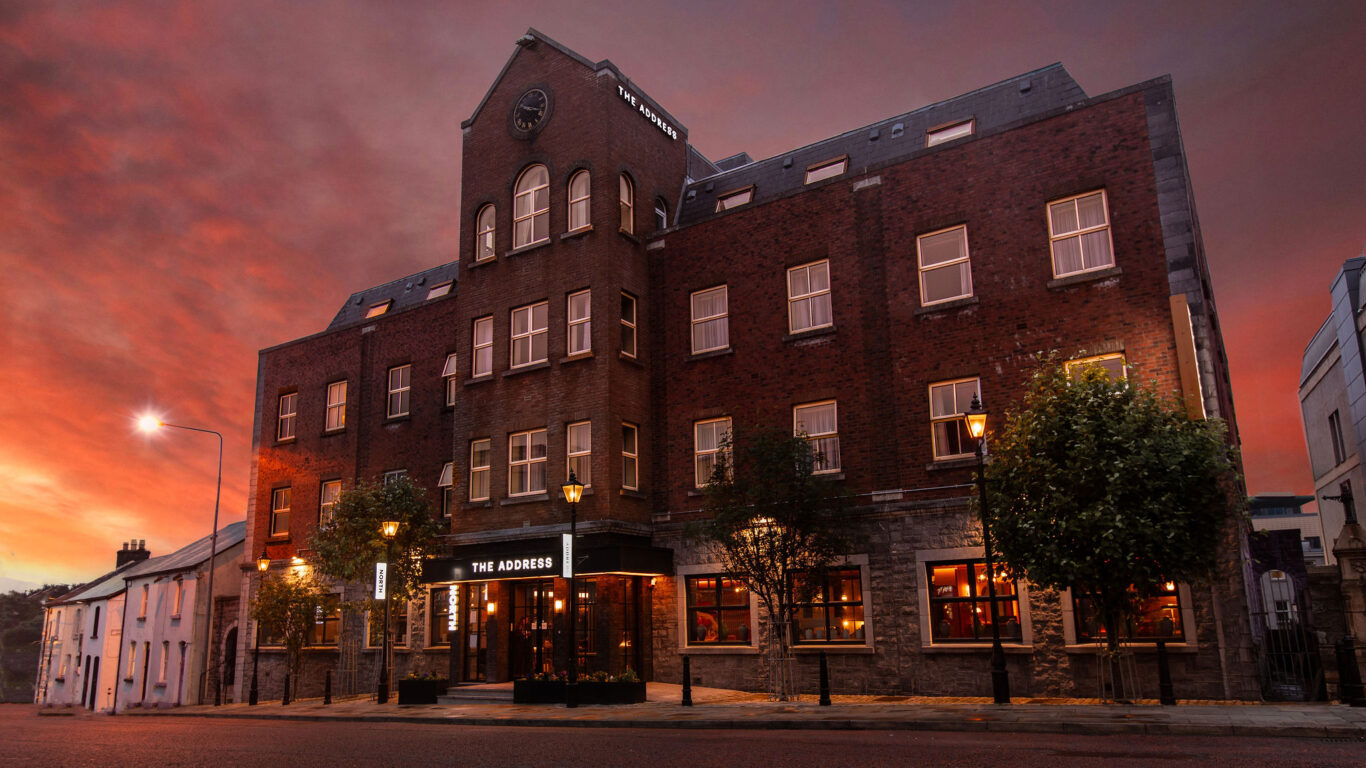History of our Address
The Address Sligo, formerly known as Sligo City Hotel, stands as a prominent fixture on Quay Street in Sligo town. Built in the mid 1990’s on one of the towns most prominent and historic streets, the hotel has embodied the locations historic economic significance by once again aiding in the town’s growth and the changing demands towards the hospitality industry.
Context and Historic Evolution
Whilst the building that houses the hotel is a relatively new one, the location of it has a rich and lengthy past. Built next to the historic Sligo Town Hall – which was itself completed in the latter half of the 19th century – the area is thought to have formerly housed a 13th century castle up until the 18th century; granting the area the name of Castlequarter. Although there are no visible above ground reminents of the castle, the areas importance to the development of the town was key.
The areas influence was once again expanded throughout the 19th and 20th centuries, a time when Sligo was solidifying its position as a key commercial hub in the northwest of Ireland. Sligo’s strategic location by the River Garavogue and its bustling port made it a natural choice for a growing number of travellers, traders, and tourists. Quay Street, where the hotel is situated, was one of the town’s busiest areas, with its proximity to the river and port activities making it a prime location for a hotel. The street proximity to the historic butter market – located on the modern-day site of the quayside shopping centre, just off Lower Quay Street – enabled the establishment of innumerable public works and private enterprises including Agents (Commission), Bacon Curers, Blacksmiths, Brokers (Ship), Builders and Contractors, Butter Merchants, Coal Merchants, Coopers, Grocers, Wine and Spirit Merchants.
Architectural Features and Development
The Address Sligo reflects the architectural trends that were popular in the late 20th century, however there are calls to the areas historic influence throughout. The building features a mix of traditional and classical elements, characterized by its solid masonry construction, symmetrical facades, and large windows that offer views of the surrounding town and river. Built to serve as a hospitality venue, the architecture speaks to the hotel’s original purpose: to provide comfortable and dignified accommodations for guests in an era when travel was becoming more common and accessible.
The design of the hotel incorporates a blend of local and contemporary influences, with attention to detail in the stonework and iron railings that were so typical in the region. The interior originally featured high ceilings, wood panelling, and open plan layout, were all elements that were intended to convey a sense of luxury and elegance. Over the years, these features have been preserved or sympathetically restored during various renovations, allowing the hotel to maintain its historical charm while adapting to modern standards.
Becoming a hotel: A Hub of Activity
Following the buildings construction it became known as the Sligo City Hotel, which quickly became a central hub for social and commercial activities in the town. The hotel was a popular venue for events, from local gatherings and civic meetings to weddings and banquets. Its central location on Quay Street made it an ideal meeting place, contributing to its reputation as a key social center in Sligo.
During this period, the hotel underwent several upgrades to meet the evolving needs of its guests. While maintaining its traditional architectural features, the hotel began to introduce modern amenities, including updated guest rooms, expanded dining facilities, and improved event spaces. These changes ensured that the hotel could continue to attract visitors in an increasingly competitive market.
Present Day: Modernization and Rebranding
As the 21st century begun and continued to progress, the hotel too continued to adapt to the changing landscape of the hospitality industry. In response to the growing expectations of travelers, the hotel underwent significant renovations and updates. These updates included the modernization of guest rooms, the installation of en-suite bathrooms, and the introduction of contemporary dining options.
In recent years, the hotel came under the McGettigan brand and rebranded as The Address Sligo, a name that reflects its commitment to providing a contemporary and welcoming experience while honouring its historical roots. The rebranding included further renovations, which enhanced the hotel’s facilities to meet modern standards of luxury and comfort. The Address Sligo now features stylishly updated rooms, state-of-the-art spa facilities, and a restaurant and bar that have become popular with both guests and locals.
Architectural Preservation and Community Role
The Address Sligo remains one of the few historic buildings in Sligo that continues to serve its original purpose. Its preservation is a testament to the town’s commitment to maintaining its heritage while embracing progress. The hotel’s architecture, with its blend of traditional and modern elements, serves as a reminder of Sligo’s rich history and its enduring appeal as a destination.
Beyond its architectural significance, The Address Sligo continues to play a vital role in the local community. It serves as a venue for an ideal base for exploring the cultural and natural attractions of Sligo and the Wild Atlantic Way. The hotel’s enduring presence on Quay Street reflects both its historical importance and its ability to adapt to the needs of successive generations of guests.
